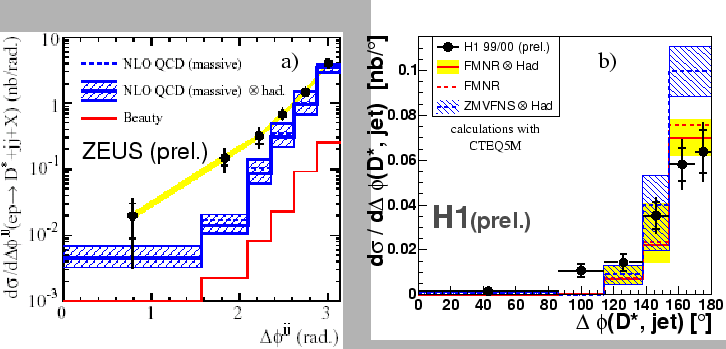Angular distribution of jets are measured
to study the distributions of the outgoing partons
and to gain understanding of the parton dynamics of the
underlying sub-processes. As described in section 2.3
different types of resolved
processes are expected to contribute.
In the case of excitation diagrams (fig.5c-d)
both quark and gluon propagators are possible.
In ![]() exchange
(fig.5d in section 2.3),
the spin
exchange
(fig.5d in section 2.3),
the spin![]() propagator of the gluon leads to a steeper angular dependence
(
propagator of the gluon leads to a steeper angular dependence
(
![]() (
(
![]() )
)![]() ) than for
quark exchange (
) than for
quark exchange (
![]() (
(
![]() )).
)).
Figures 26c-f show the differential
cross section
![]() for both direct (
for both direct (
![]() )
and resolved enriched (
)
and resolved enriched (
![]() )
samples [17].
Here,
)
samples [17].
Here,
![]() is the angle between the charm-jet axis
and the
is the angle between the charm-jet axis
and the ![]() -beam direction in the dijet rest frame.
The charm jet is identified by association of the
-beam direction in the dijet rest frame.
The charm jet is identified by association of the ![]() meson with the
jet using a criterion
meson with the
jet using a criterion
![]() .
Positive (negative) values of
.
Positive (negative) values of
![]() correspond to cases in which the
identified charm jet, which is associated to the reconstructed
correspond to cases in which the
identified charm jet, which is associated to the reconstructed ![]() meson,
is oriented in the direction of the incoming proton (photon).
The shaded areas for
meson,
is oriented in the direction of the incoming proton (photon).
The shaded areas for
![]() and
and
![]() are, respectively, the contamination
of the genuine direct and resolved PYTHIA contributions.
The measured differential cross sections
are, respectively, the contamination
of the genuine direct and resolved PYTHIA contributions.
The measured differential cross sections
![]() for both samples are significantly
different. For
for both samples are significantly
different. For
![]() a
particular enhancement of the cross section for
charm jets is seen in the photon direction (negative
a
particular enhancement of the cross section for
charm jets is seen in the photon direction (negative
![]() ).
In contrast, in the region
).
In contrast, in the region
![]() the angular
distributions reveal a much shallower behaviour.
The differences provide an indication that a sizable fraction of the
resolved photon events proceeds via gluon exchange for which a steep
angular distribution is expected.
the angular
distributions reveal a much shallower behaviour.
The differences provide an indication that a sizable fraction of the
resolved photon events proceeds via gluon exchange for which a steep
angular distribution is expected.
 |
New preliminary results are available
for the angular correlations in azimuth in charmed photoproduction events containing jets.
In leading order the
![]() distribution is expected to show a sharp peak at
distribution is expected to show a sharp peak at
![]() .
Contributions from higher orders, i.e. hard gluon radiation, as well as fragmentation and
detector resolution effects smear the distributions out.
The ZEUS experiment uses a dijet sample to measure the difference
.
Contributions from higher orders, i.e. hard gluon radiation, as well as fragmentation and
detector resolution effects smear the distributions out.
The ZEUS experiment uses a dijet sample to measure the difference
![]() of the two
jets [25] while H1 measures the difference between the reconstructed
of the two
jets [25] while H1 measures the difference between the reconstructed
![]() meson and the leading jet which does not belong to the
meson and the leading jet which does not belong to the ![]() meson [9].
In fig27 the two measurements are shown, revealing similar features.
The data have a shallower behaviour in
meson [9].
In fig27 the two measurements are shown, revealing similar features.
The data have a shallower behaviour in
![]() than the theories,
indicating that the theories, at next-to-leading order, can not fully account
for the amount of gluon radiation seen in the data.
than the theories,
indicating that the theories, at next-to-leading order, can not fully account
for the amount of gluon radiation seen in the data.